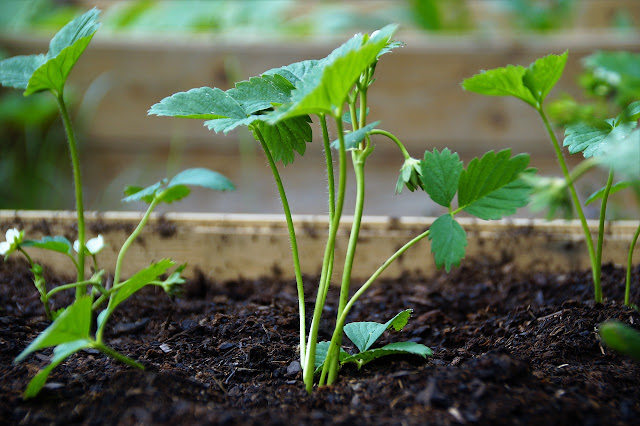Growing strawberries from seed is a best way to get plants without spending lot of money. Growing strawberries from seed had never occurred to me until a friend showed me her lovely strawberry plants. Plants for strawberries are readily available, but the variety is limited. A seed firm won't bother cultivating bare-root plants unless they can sell a whole field of them. As a result, the truly unusual, speciality types are becoming increasingly rare.
We've planted some lovely heirloom strawberries to try this year, and I'm thinking of hanging the majority of them in hanging baskets out of the reach of my two strawberry monsters.
Where to buy strawberry seeds?
There are a few shops that offer specialist strawberry seed, and they're all old heritage or wild alpine kinds. In any case, you're in for a treat because these types aren't available in stores. If you're looking for strawberry seeds for sale online, make sure you go with a reliable seller. Use the link below to browse our online supplier directory and shop for strawberry seeds.
Where To Plant Strawberries
Strawberries grow best in a sunny, sheltered spot with fertile, well-draining soil. Make sure to put enough of organic matter, such as compost or well-rotted manure, into the soil before planting to give your seedlings the best possible start. You can still produce strawberries in your garden if it doesn't get enough sunshine. Summer and everlasting fruiting kinds will not yield as much, but they will thrive in semi-shade. If in doubt, plant alpine types, which prefer a shadier environment.
Growing Strawberry Plants From Seeds
It's more difficult to grow strawberry plants from seed than it is to buy strawberry plants. It can, however, be far more rewarding. Choosing your favorite Strawberry Varieties is the first step in growing strawberries from seed. You're ready to plant strawberries once you've chosen the proper variety for your garden and purchased strawberry seeds. Strawberry seeds from most hybrid varieties, on the other hand, will not reproduce true to form. Alpine types and heirloom seeds, as well as a few new F1 cultivars, frequently do, so keep that in mind when sowing strawberry seeds.
To encourage germination, many strawberry seeds must be cold. Don't worry if your chosen seeds require it. It's simple. Simply cover your seeds in plastic wrap and set them in an airtight container in the freezer. This simulates winter temperatures, and the warming phase signals to the seed that it's time to grow. Remove the strawberry seeds from the freezer after two to four weeks of keeping them below freezing. Allow them to gradually warm up to room temperature in the jar or container.
When your strawberry seeds have reached room temperature and are ready to be planted, you must provide a welcoming environment for them to begin their trip to planthood. A seed tray is ideal. Obtain and prepare a seed tray. 3 parts peat to 1 part organic-rich soil is a suitable combination for beginning strawberry seedlings. Spread this out to a depth of approximately a half-inch in your seed tray.
Using water, wet the mixture until it is uniformly moist. Sprinkle your strawberry seeds over the moist mixture, and then lightly sprinkle the seeds with peat moss. Make sure the strawberry seeds aren't totally covered and that they have access to light. If feasible, keep them indoors in a well-lit environment with direct sunshine. Strawberry seeds should germinate in two to three weeks.
Maintain a moist, well-lit environment for the soil. Warmth can aid seed germination, so the top of a refrigerator or a heat pad on the bottom can be ideal locations for germination. Consider adding more artificial light if the strawberry plant seedlings aren't in direct sunlight with supplemental light.
It will enough to use a fluorescent shop light or a grow light. Place the light source 3 to 4 inches from the seedlings, and gradually increase the light intensity as the strawberry plants develop. If the strawberry seeds sprout too close together, thin them out when they reach 1 to 2 inches tall, preserving the largest and most vigorous seedlings. After the strawberry seedlings have developed their third leaf, gently transplant them to bigger containers or pots.
The strawberry seedlings can be planted directly outdoors if the conditions allow, or the plants in the pots can be transplanted outside if the weather permits. If you started your strawberry seeds indoors, you'll need to harden them off before planting them outside. When the weather rises into the 50s, start bringing the plants outside for several hours each day in the shade.
Gradually increase the amount of time the plants spend outside, eventually putting them out overnight if the weather permits. To continue the hardening off process before planting, start bringing them into the sun for longer periods of time. This guarantees that your plants are neither harmed or died as a result of environmental changes.
Harvesting
Strawberries may be harvested as soon as they turn red (or white, depending on the type). They'll still be good in jams and other cooked-fruit dishes if they've gone a little too long and are soft and mushy. If the birds are out-harvesting you, consider draping bird netting over your plants.
You should be able to get several years of life out of your strawberries if you carefully care for them each season.



.png)







Comments
Post a Comment